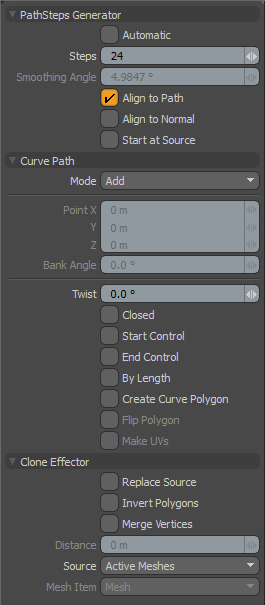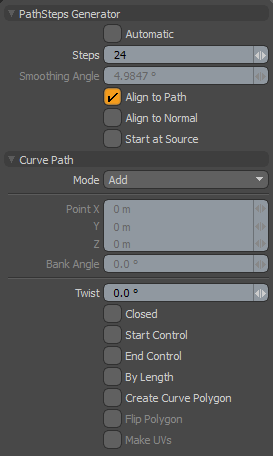
The Curve Clone tool allows you to quickly clone geometry by clicking down control points for a curve. The cloned element is determined by the settings of the Source option of the Clone Effector. As the curve is created, the specified geometry duplicates itself along the curve in real-time (depending on system performance). You may want to begin with a pre-created curve; simply put the curve in a visible, but deselected Mesh Item, prior to activating the tool (also known as a Background item). Once the second vertex of the curve has been created with the tool, the clone effector creates geometry along it, using the various controls.

The following properties are available for the Curve Clone tool.
|
Path Steps Generator |
|
|---|---|
|
Automatic |
Forces a computed number of clones based on the Smoothing Angle value, such that a clone is placed along the path to maintain a level of smoothness at or above the user-set level (determined by the Smoothing Angle). |
|
Steps |
Active only when the Automatic option is disabled. The defined Steps value determines the number of particles generated along the curve path that feed into the Effector, essentially controlling the number of clones. |
|
Smoothing Angle |
Determines the angle along the curve where a clone is created when the Automatic option is enabled. |
|
Align to Path |
When enabled, the generated particles include rotation information so the newly-created clone aligns to the path vector direction at the location where it is created. |
|
Align to Normal |
When enabled, the generated particles include rotation information so the newly-created clone aligns with any stored normal direction for a vertex, such as for a curve extracted from geometry. |
|
Start at Source |
Often a curve used for cloning has its initial control knot imperfectly aligned with the geometry to be cloned. With Start at Source active, the curve is used as a relative guide using the original geometry as the true starting location. Disabling this option may cause the newly-created geometry to move away from the intended original location. |
|
Curve Path |
|
|
Mode |
By default, the mode is set to Add. In the Add mode, clicking on a curve point and dragging edits the curve's position. Clicking anywhere in the 3D Viewport other than the handles create a new curve control point. To avoid creating new control points when dragging existing points around you can set this mode to Edit. The Delete mode allows quick removal of control points by simply clicking on them. |
|
Point X/Y/Z |
The XYZ position of the currently selected knot. You can interactively edit the position by clicking over the knot indicated by the cyan dot. It turns yellow and you can now drag its position around in the viewport, or manually enter a position by editing any of the data fields. |
|
Bank Angle |
For each path position, a bank angle can be defined that controls the rotation angle of elements cloned through that position. |
|
Twist |
Works just like the Bank Angle option, but instead of being calculated per knot, the rotation amount is defined across the entire length of the curve, where the Twist value represents the amount of twisting rotation from the first knot in the curve to the last knot. |
|
Closed |
Causes the curve to become a closed loop, connecting the end point to the start. |
|
Start Control |
Enabling this toggle causes the first knot in the curve to become a control point, but not an actual segment of the curve. This provides a simple method for changing the curvature at the start of the curve. |
|
End Control |
Enabling this toggle causes the last knot in the curve to become a control point, but not an actual segment of the curve. This provides a simple method for changing the curvature at the end of the curve. |
|
By Length |
Forces the newly-created geometry to be evenly distributed across the entire length of the curve rather than spacing based on the control knots. |
|
Create Curve Polygon |
Generates a curve type polygon that remains after the tool has been dropped. This is useful if you want to re-use the curve you create with the current tool, with additional curve-based tools later in your project. |
|
Flip Polygon |
Invert the faces of the generated polygons. |
|
Make UVs |
When this toggle is active, the tool populates the current UV map with data for the generated polygons. |
|
Clone Effector |
|
|
Replace Source |
When this option is enabled, Modo removes the source geometry and position it at the first Point in the path. |
|
Invert Polygons |
When enabled, this option inverts the normal direction of the cloned geometry. |
|
Merge Vertices |
When enabled, this option merges coinciding vertices into a single vertex (based on a specified Distance value). |
|
Distance |
Used in conjunction with the Merge Vertices option, the Distance value determines the maximum distance between vertices where merging occurs. Vertices outside this value remain unchanged. A value of zero only removes collocated vertices. |
|
Source |
Determines the mesh that is cloned along the Pen tool path. • Active Meshes - uses the currently-selected geometry as a clone source. • Specific Mesh - allows you to specify a specific Mesh Item as the clone source using the Mesh Item option below. • All BG - combines all the currently-visible background items, cloning them as a single mesh. • Random BG - chooses a random background item from all the currently-visible background items at each clone position. • Preset Shape - allows you to clone Profile shapes from the Preset Browser. Open the Preset Browser (F6) and select a profile before activating the tool. |
|
Mesh Item |
Works when the Source is set to Specific Mesh and allows you to set the mesh to be cloned. |
With the Curve Instance clone you can create instances of a geometry by clicking down control points for a curve. To activate the tool, right-click the Curve Clone tool icon in the Duplicate sub-tab of the modeling toolbox, and select Curve Instance.

In addition to the PathSteps Generator and Curve Path properties described in the Curve Clone section, the following properties are available for the Curve Instance tool:
|
Item Effector |
|
|---|---|
|
Parent |
Determines how Modo treats instanced items in the Item List. |
|
Instance |
When enabled, each cloned item is an instance of the source mesh. Instances contain no physical geometry, but they reference a source layer and are represented in 3D Viewports by pink wireframes. (This is enabled by default.) |
|
Bounding Box |
When enabled, the resulting instances display as bounding boxes rather than wireframe meshes. This may provide a 3D Viewport performance increase when Modo generates many instances. |
|
Hierarchy |
|
|
Source |
Determines the source mesh that Modo clones onto the curve. |
|
Item |
Specifies the item to be cloned. This is only relevant if you set Source to Specific Item. |
|
Mesh Presets |
|
|
Meshes |
Opens the Preset Browser, where you can select a mesh preset to use as the Source. |
The Curve Replica tool works like the Curve Clone tool, but creates replicas instead of actual meshes. To activate the tool, right-click the Curve Clone tool icon in the Duplicate sub-tab of the modeling toolbox, and select Curve Replica.

In addition to the PathSteps Generator and Curve Path properties described in the Curve Clone section, the following properties are available for the Curve Replica tool:
|
Replica Effector |
|
|---|---|
|
Source |
Determines the source mesh that Modo clones onto the curve. |
|
Item |
Specifies the item to be cloned. This is only relevant if you set Source to Specific Item. |
|
Mesh Presets |
|
|
Meshes |
Opens the Preset Browser, where you can select a mesh preset to use as the Source. |
With the Curve Transform tool, you can organize your existing geometry along the path of a curve. To activate the tool, right-click the Curve Clone tool icon in the Duplicate sub-tab of the modeling toolbox, and select Curve Transform.

The available PathSteps Generator and Curve Path properties are described in the Curve Clone section.